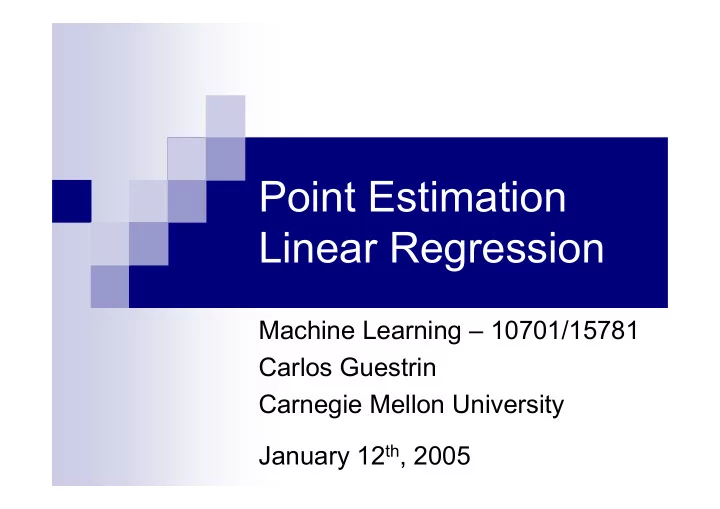

Point Estimation Linear Regression Machine Learning – 10701/15781 Carlos Guestrin Carnegie Mellon University January 12 th , 2005
Announcements � Recitations – New Day and Room � Doherty Hall 1212 � Thursdays – 5-6:30pm � Starting January 20 th � Use mailing list � 701-instructors@boysenberry.srv.cs.cmu.edu
Your first consulting job � A billionaire from the suburbs of Seattle asks you a question: � He says: I have thumbtack, if I flip it, what’s the probability it will fall with the nail up? � You say: Please flip it a few times: � You say: The probability is: � He says: Why??? � You say: Because…
Thumbtack – Binomial Distribution � P(Heads) = θ , P(Tails) = 1- θ � Flips are i.i.d.: � Independent events � Identically distributed according to Binomial distribution � Sequence D of α H Heads and α T Tails
Maximum Likelihood Estimation � Data: Observed set D of α H Heads and α T Tails � Hypothesis: Binomial distribution � Learning θ is an optimization problem � What’s the objective function? � MLE: Choose θ that maximizes the probability of observed data:
Your first learning algorithm � Set derivative to zero:
How many flips do I need? � Billionaire says: I flipped 3 heads and 2 tails. � You say: θ = 3/5, I can prove it! � He says: What if I flipped 30 heads and 20 tails? � You say: Same answer, I can prove it! � He says: What’s better? � You say: Humm… The more the merrier??? � He says: Is this why I am paying you the big bucks???
Simple bound (based on Hoeffding’s inequality) � For N = α H + α T , and � Let θ * be the true parameter, for any ε >0:
PAC Learning � PAC: Probably Approximate Correct � Billionaire says: I want to know the thumbtack parameter θ , within ε = 0.1, with probability at least 1- δ = 0.95. How many flips?
What about prior � Billionaire says: Wait, I know that the thumbtack is “close” to 50-50. What can you? � You say: I can learn it the Bayesian way… � Rather than estimating a single θ , we obtain a distribution over possible values of θ
Bayesian Learning � Use Bayes rule: � Or equivalently:
Bayesian Learning for Thumbtack � Likelihood function is simply Binomial: � What about prior? � Represent expert knowledge � Simple posterior form � Conjugate priors: � Closed-form representation of posterior � For Binomial, conjugate prior is Beta distribution
Beta prior distribution – P( θ ) � Likelihood function: � Posterior:
Posterior distribution � Prior: � Data: α H heads and α T tails � Posterior distribution:
Using Bayesian posterior � Posterior distribution: � Bayesian inference: � No longer single parameter: � Integral is often hard to compute
MAP: Maximum a posteriori approximation � As more data is observed, Beta is more certain � MAP: use most likely parameter:
MAP for Beta distribution � MAP: use most likely parameter: � Beta prior equivalent to extra thumbtack flips � As N → ∞ , prior is “forgotten” � But, for small sample size, prior is important!
What about continuous variables? � Billionaire says: If I am measuring a continuous variable, what can you do for me? � You say: Let me tell you about Gaussians…
MLE for Gaussian � Prob. of i.i.d. samples x 1 ,…,x N : � Log-likelihood of data:
Your second learning algorithm: MLE for mean of a Gaussian � What’s MLE for mean?
MLE for variance � Again, set derivative to zero:
Learning Gaussian parameters � MLE: � Bayesian learning is also possible � Conjugate priors � Mean: Gaussian prior � Variance: Wishart Distribution
Prediction of continuous variables � Billionaire says: Wait, that’s not what I meant! � You says: Chill out, dude. � He says: I want to predict a continuous variable for continuous inputs: I want to predict salaries from GPA. � You say: I can regress that…
The regression problem � Instances: < x j , t j > � Learn: Mapping from x to t( x ) � Hypothesis space: � Given, basis functions � Find coeffs w ={w 1 ,…,w k } � Precisely, minimize the residual error: � Solve with simple matrix operations: � Set derivative to zero � Go to recitation Thursday 1/20
But, why? � Billionaire (again) says: Why sum squared error??? � You say: Gaussians, Dr. Gateson, Gaussians… � Model: � Learn w using MLE
Maximizing log-likelihood Maximize:
Bias-Variance Tradeoff � Choice of hypothesis class introduces learning bias � More complex class → less bias � More complex class → more variance
What you need to know � Go to recitation for regression � And, other recitations too � Point estimation: � MLE � Bayesian learning � MAP � Gaussian estimation � Regression � Basis function = features � Optimizing sum squared error � Relationship between regression and Gaussians � Bias-Variance trade-off
Recommend
More recommend